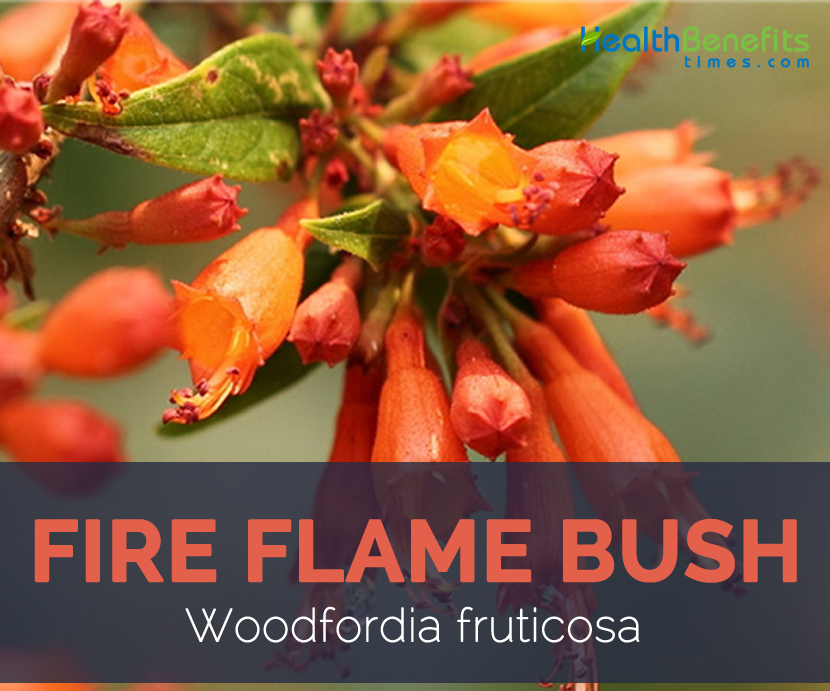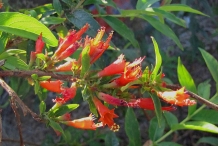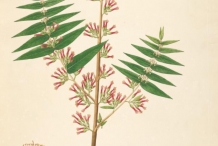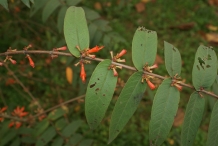| Fire Flame Bush Quick Facts |
| Name: |
Fire Flame Bush |
| Scientific Name: |
Woodfordia fruticosa |
| Origin |
Asia and Africa |
| Shapes |
Capsules about 1cm long, ellipsoid and membranous, 6-10 mm long, 2.5-4.5 mm broad. |
| Taste |
Astringent in taste |
Woodfordia fruticosa L. belonging to family Lythraceae is an ecologically as well as economically important shrub species of tropical dry mixed forests. It is endemic to India and is also available in Madagascar, Pakistan, Ceylon, Nepal, Bhutan, Myanmar, Indonesia and China. In India plant of woodfordia is distributed in Arunachal Pradesh, Mizoram and West Bengal. It is used as ingredient in many products for its medicinal values. At the same time, it is also used as a fermenting agent in Asava and Arishta (such as Dashamoolarishta). Apart from Fire flame bush it is also known as Red Bell Bush, Shinajitea, Woodfordia, Dhataki, Dhai-phul, Agnijwala, Tamrapushpi and Tatiri. It is a spreading, leafy shrub, small in size but very conspicuous on dry, rocky hillsides from December to May. It is a valuable multipurpose plant and has been exploited commercially as a source of tannins and dyes. It is also an excellent pioneer species, is used medicinally and has minor food uses.
Plant
Fire Flame Bush is much branched, deciduous shrub with several fluted branches. This shrub has spreading branches reaching height up to 5-12 mt. Branches are normally long and multi spreading and stem is fluted and long. Bark of the shrub is smooth and reddish brown in color with very thin and small fibrous stripes. Leaves are about 5-9 cm long, 8-30 mm broad, lanceolate, oblong-lanceolate or ovate-lanceolate; opposite and pale on lower side. This shrub bears numerous flowers that are bright red in color. Small flowers of this herb grow singly or in groups along the twigs and branches. Every flower of this herb, borne a tiny stem, slender tube, curved and greenish base. Fruits are capsules about 6-10 mm long, 2.5-4.5 mm broad, ellipsoid and membranous and contain numerous very minute, brown colored shining, smooth obovate seeds. Shrub is overloaded with bright red flowers in the month of February to April and its leaves shed off and new leaves appear. Its fruits appear from April to June.
History
Fire Flame bush is medicinal herb of Ayurvedic medicine system and it is native to Asia and Africa. In India and it is amply distributed throughout north India, to an ascending altitude of 1500 mt. Mostly it is available in waste lands and open grasslands but it is also cultivated in gardens during the summer months. But nowadays it is available in Madagascar, Pakistan, Ceylon, Nepal, Bhutan, Myanmar, Indonesia and China. In India plant of woodfordia is distributed in Arunachal Pradesh, Mizoram and West Bengal.
Traditional Medicinal uses
- They are useful in the conditions of kapha and pitta, leprosy, burning sensation, skin diseases, diarrhea, dysentery, fever, headache, hemorrhoids, herpes, internal hemorrhage, leucorrhea, liver disorders, menorrhagia, ulcers, and wounds.
- Juice of leaves is used in bilious sickness.
- They are valued as a stimulant in pregnancy.
- Dried flower powder is used in ulcers and wounds to reduce the discharge and promote granulation.
- Juice of its fresh flowers applied on the forehead and reduces the headache.
- Bark is used for treating various disorders like leprosy, erysipelas, thirst, dysentery and various diseases of blood.
- It is used to cure diarrhea, piles and dysentery because it is a powerful astringent.
- Flower is applied externally to relieve burning sensation of skin.
- Flowers are sprinkled over wounds and ulcers for quick healing and to stop discharge and granulation.
- Flowers are applied along with coconut oil to relieve burns.
- It is also used to boost up immunity and overall body health.
- Decoction of flowers is used for treating vaginal prolapse and anal prolapse.
- It is also used as gargles to cure dental disorders.
- Flower is used to reduce menstrual pain and it is also used to cure leucorrhoea.
- Flowers and roots are very effective in curing rheumatism, lumbar and rib fractures, and foot and mouth diseases.
- Decoction of flowers is used to reduce thirst and other mouth related disorders in diabetic patients.
- It is also used in the treatment of fever that is caused due to pitta dosha.
- Flowers are used for the victims who are addicted to opium and suffering with diarrhea.
- Dried flowers are very beneficial for overall heart health and used to treat various heart related disorders.
- Powder of flowers with honey helps to check loose motion.
- Use of flowers with giloy and amla helps to cure fever.
- Powder of Fire Flame Bush flowers with honey or rice water is useful in white discharge in females.
- Neem leaves with Fire Flame Bush flowers are helpful in skin disorders.
- Pipali powder mixed with powder of flowers when rubbed at the teething place of the children helps to erupt teeth smoothly.
- Decoction of flowers is useful locally for the patients of prolapsed of anus.
- The infusion of the dried flowers is used for hemorrhoids and derangement of the liver.
- Dried flower powder is used in ulcers and wounds to reduce the discharge and promote granulation.
- In chronic diarrhea, flowers combined with mocarasa and indrayava is a very effective medicament.
- The jam (avaleha) prepared of its flowers, helps in controlling bleeding in menorrhagia as well as it alleviates the leucorrhoea.
Other Facts
- Leaves and twigs of this plant produce a yellow dye that is used for printing.
- Petals of this plant yield a red colored dye.
- A gum is obtained from the plant. It is similar to gum tragacanth.
- The wood is used for fuel.
Fire Flame Bush Facts
Fire Flame Bush is a much-branched, beautiful shrub, with fluted stems and long, spreading branches commonly occurring throughout North India and sometimes cultivated in gardens for its flowers. When in flower the bush appears twiggy and formless but entirely swathed in red. This is because the small flowers grow singly or in groups all the way along the branches and side twigs, and it is at this time that the leaves fall. Each flower, borne on a tiny stem, is a slender tube, slightly curved, the greenish base of which is the sepal. Swelling slightly, the tube divides into narrow, pointed lobes and from within emerges a bunch of long stamens. The flowers are very useful in dysentery, diarrhea, fever, hemorrhoids, herpes, leprosy, burning sensation, skin diseases, internal hemorrhage, impaired hepatic function, leucorrhea, and menorrhagia and considered as a safe stimulant pregnancy. The juice of its fresh flowers applied on the forehead, reduces the headache. Dried flower powder is used in ulcers and wounds to reduce the discharge and promote granulation.
| Name |
Fire Flame Bush |
| Scientific Name |
Woodfordia fruticosa |
| Native |
Asia and Africa |
| Common Names |
Fire Flame Bush, Red Bell Bush, Shinajitea, Woodfordia, Dhataki, Dhai-phul, Agnijwala, Tamrapushpi, Tatiri |
| Name in Other Languages |
Bihar: Dhai, Dawai
Chinese: 吴福花, 虾子花
English: Fire Flame Bush, Shiranjitea, Woodfordia, Dhawai flower
Hindi: Dhawai, Dawi, Dhawai phool, Dhaura, Jaju, Santha.
Indian name: Ban-mahendi, Dhai, Dhati, Dhatki, Dhatri, Dhaura
Jammu and Kashmir: Thwai
Marathi: Dowari, Dhalas, Dhayati, Dhadva, Dhaiphal, Phulsatti.
Nepali: Dhangera
Tamil: Velakkai, Dhathari-jagri, Dhattari
Malayalam: Tamarpushi, Tatire, Tatiripushpi, Thathiri, Thathiripoovu
Telugu: Dhaarhupushpika, Dhaathaki, Godari, Jargi Seringi, Errapurvu, Seringi, Sirinji.
Kannada: Tamrapuspi, Bela, Taamra pushpin, Daathakee kusumka
Oriya: Dhobo, Jaliko, Harwari
Konkani: Dhauri
Urdu: Jetiko
Gujarati: Dhawani, Dhavdi, Dhavadina.
Sanskrit: Parvati, Bahupuspika, Agnijwala
Tibetan: Dha-ta-ke, Me-togda tak ki
Urdu: Gul dhawa, Jetiko
Gujarati: Dhaavadi, Dhawani
Bengali: Dhai, Dawai, Dhai phul
Punjabi: Dhavi
Farsi: Dhaava
Sanskrit: Bahupuspika, Parvati, Agnijvala, Agnijwala, Dhalaki, Dhataki, Dhauri |
| Plant Growth Habit |
Much-branched, beautiful shrub |
| Plant Size |
5-12 feet in height. |
| Branches |
Long and multi spreading |
| Bark |
Smooth and reddish brown in color with very thin and small fibrous stripes |
| Stem |
Fluted and long |
| Leaf |
About 5-9cm long, 8-30 mm broad., lanceolate, oblong-lanceolate or ovate-lanceolate; opposite and pale on lower side. |
| Flowering Season |
January and April. |
| Flower |
Numerous, small, brilliant red in dense axillary paniculate- cymose clusters, borne a tiny stem, slender tube, curved and greenish base. |
| Fruit Shape & Size |
Capsules about 1cm long, ellipsoid and membranous, 6-10 mm long, 2.5-4.5 mm broad. |
| Taste |
Astringent in taste |
| Seed |
Numerous very minute, brown colored shining, smooth obovate seeds. |
| Season |
April and May |
References:
http://healthyliving.natureloc.com/thathiripoovu-woodfordia-fruticosa-fire-flame-bush/
http://www.flowersofindia.net/catalog/slides/Fire%20Flame%20Bush.html
http://www.planetayurveda.com/library/dhataki-woodfordia-fruticosa
http://healthyminute.in/2014/05/09/benefits-and-uses-of-dhataki-woodfordia-fruticosa/
https://sites.google.com/site/medicinalplantshealing/list-of-plants/fire-flame-bush
http://technoayurveda.com/dhataki.html
http://findmeacure.com/2009/03/18/dhataki-woodfordia-fruticosa/
http://www.phytojournal.com/archives/2016/vol5issue3/PartD/5-4-23-862.pdf
http://holisticonline.com/Herbal-Med/_Herbs/h143.htm
https://en.wikipedia.org/wiki/Woodfordia_fruticosa
http://envis.frlht.org/plant_details.php?disp_id=2234&parname=0
http://tropical.theferns.info/viewtropical.php?id=Woodfordia+fruticosa
https://www.ncbi.nlm.nih.gov/pubmed/17276634
http://www.ars-grin.gov/misc/mmpnd/Woodfordia.html
https://npgsweb.ars-grin.gov/gringlobal/taxonomydetail.aspx?42056
Comments
comments





